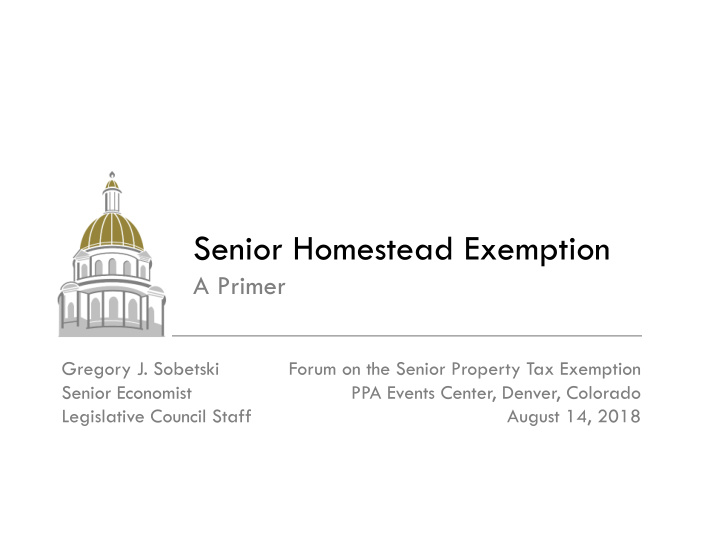



Senior Homestead Exemption A Primer Gregory J. Sobetski Forum on the Senior Property Tax Exemption Senior Economist PPA Events Center, Denver, Colorado Legislative Council Staff August 14, 2018
Back in 2000… • Legislative referred measure • Proponents: – Colorado Senior Lobby – AARP Colorado – other citizens • Referendum A enacted at 2000 Election – 54.7 percent support • Took effect in 2002 2
How it Works for Seniors • Applies to seniors age 65+, or surviving spouses • Property must be primary residence • Continuously owned and occupied for at least 10 years • 50 percent of first $200,000 exempt from property tax – e.g., for a $166,000 residence, taxed as if $83,000 – e.g., for a $265,000 residence, taxed as if $165,000 • Property tax benefit depends on home value and local mill levy (averaged $499 in 2002; $545 in 2017) 3
How it Works for Governments • Only local governments assess property tax • Constitution requires state government to reimburse local governments for their revenue loss • State General Fund expenditure for local government reimbursements in the fiscal year that taxes are paid • Constitution allows state legislature to adjust $200,000 cap 4
Arguments For (2000 Blue Book) • Assists low-income seniors with rising tax burden • Allows long-time senior residents to age in place • Makes up for low levels of participation in the state property tax deferral program 5
Arguments Against (2000 Blue Book) • Not means-tested; benefits seniors for whom tax is less burdensome • Unnecessary given other tax benefits provided to seniors, including income tax deduction for retirement income and property tax deferral program • Masks future costs of property tax increases, since these costs are passed through to the state 6
Home prices and mill levies have raised exemption values Sources: Division of Property Taxation; Department of the Treasury; Legislative Council Staff *Indicates years when the exemption cap was set to zero by the state legislature “f” indicates forecast 7
…but state costs are mostly demographic-driven Sources: Division of Property Taxation; Department of the Treasury; Legislative Council Staff *Indicates years when the exemption cap was set to zero by the state legislature “f” indicates forecast 8
…and the senior population is poised to surge Source: Department of Local Affairs, State Demography Office. 9
Budgetary Consequences • Reimbursements paid from the General Fund • Commitment rises independent of economic conditions • Legislature has eliminated benefit in years of budget shortfall • Under Senate Bill 17-267, now a TABOR refund mechanism – May protect against cuts in TABOR years – May not protect against cuts in recession years 10
Some Parameters are Set in the Constitution • Colo. Const., art. X, § 3 (1)(a): “Each property tax levy shall be uniform upon all real and personal property not exempt from taxation under this article[…]” – So neither the legislature nor local governments can create a new property tax expenditure • These parameters are fixed in the constitution: – The age threshold (65 years) – The residency threshold (10 years) • Imposing additional eligibility requirements without voter approval is constitutionally complicated, and may be unconstitutional 11
One parameter can be altered in statute • The constitution allows the legislature to change the home value cap (currently $200,000) – The cap could be set at a level calculated to limit the cost of the exemption to some amount chosen by the legislature • Some members have proposed setting the cap at $0 and providing alternative benefits to seniors – These benefits would not be direct property tax exemptions – They could be made available via the income tax form – They could be means-tested, or consider the percentage of income that a senior spends on property tax – They could be made available to seniors who do not own their homes 12
Questions? Gregory J. Sobetski Senior Economist • Legislative Council Staff greg.sobetski@state.co.us • (303) 866-4105 www.leg.colorado.gov/lcs 13
Recommend
More recommend